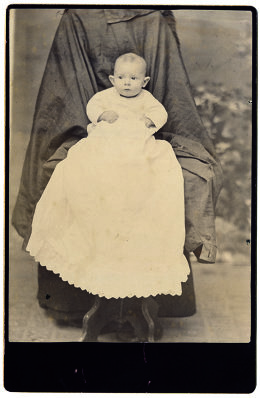Next time you see an old black-and-white photograph of a baby, look closer. That baby's mother might be hidden in the photograph. In fact, once you know what you're looking for, you'll probably start seeing mothers everywhere: Buried beneath carpets, squatting behind chairs, and covered in blankets.
Mothers hiding themselves in the baby portraits of the late 19th and early 20th century is the subject of a new book edited by Milanese artist Linda Fregni Nagler. The Hidden Mother is a collection of 1,002 photographs (from daguerrotypes to cartes de visite, and cabinet cards) in which a mother is hiding somewhere in the portrait of her progeny.

To understand the photographs inside The Hidden Mother, you first need to understand the technical realities of early photography. Unlike the quick snap of picture-taking today, the subject of a portrait in the 19th century needed to sit still for a lot longer. If you wanted a daguerrotype of your baby, you needed to keep the sucker still for between 60 and 90 seconds. Anyone who has ever tried to take a picture of a squealing, squirming kid can comprehend the difficulties.
Because of this, mothers were frequently enlisted to keep their children still during the shot. But instead of posing with the children, mothers instead opted to obscure themselves, resulting in photographs in which a mother is holding a child while completely covered in a brocade.
"To catalog the Hidden Mothers for my archives, I have used a number of keywords which categorize the many ways in which they hid themselves," Fregni tells Co.Design. "Those keywords are highly descriptive: burqa, cut out mother, phantom limb, cloth, big hand, darkroom trick, ink spot, head from behind, cropped head, furniture, metal matte, and so on."

Why didn't the mothers simply pose with their children? According to Nagler, it reflects one of the core instincts of motherhood: to deny oneself in deference to the child. In the case of the photographs compiled in The Hidden Mother, Nagler notes that mothers have often opted to hide themselves in order to immortalize a child who might not live to be the subject of another photo, owing to the high infant mortality rates of the period.
Put in that light, the photographs of the camouflaged parents in The Hidden Mother stop being comic. The supreme instinct of a parent is self-negation for the sake of his or her children. It is through this act of self-negation that the parents of The Hidden Mother have now been immortalized.
The Hidden Mother is available now from Mack Books.